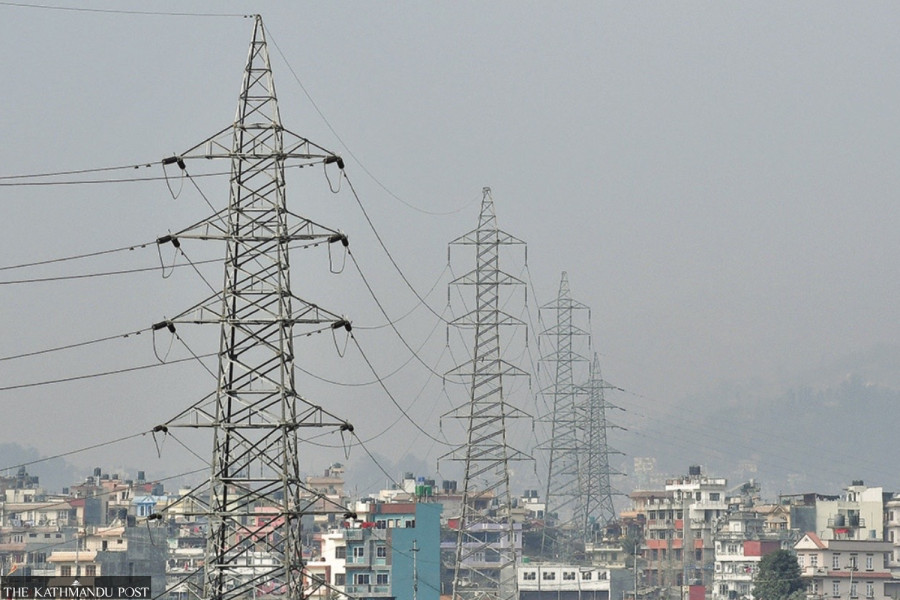National
Obstructions in multiple projects trip NEA’s transmission upgrade
With domestic power production rising, obstruction in transmission projects emerges as a major challenge in evacuating power.
Prithvi Man Shrestha
Nepal Electricity Authority has been facing one trouble after another in developing transmission line projects. It has been facing problems to construct the 220kV Kaligandaki Corridor Transmission line at Phalebas area of Parbat for the last three years.
The locals have been obstructing the construction, demanding a realignment of the project. They have claimed that the power line would cause damage to a school at Devisthan in Phalebas-6 and a stadium.
According to the NEA, four transmission towers could not be constructed in the Phalebas area due to the locals’ obstructions.
On Tuesday, a group of electricity officials headed by Kul Man Ghising reached the Phalebas area. Chief District Officer Chitrangat Baral and Phalebas Municipality Mayor Gangadhar Tiwari also joined the team, according to the NEA. They held discussions with the locals.
During the discussion, the team urged the residents not to obstruct the construction work as the facility is important for the evacuation of power from hydropower plants developed on the Kaligandaki river and its tributary rivers and streams, the NEA said in a statement. The team also urged them to help with the project as the NEA has failed to transmit electricity in the rainy season.
Ghising said the NEA would conduct a survey in the next 4–5 days whether the proposed power line could be realigned.
Elsewhere, people of Lapsephedi in Shankarapur Municipality-3 on the outskirts of Kathmandu have also been obstructing the construction of a substation there.
The NEA and the local residents are at loggerheads over the plan to construct the substation for the 400kV Naya Khimti-Barhabise-Lapsephedi transmission line, which it says is vital for meeting the growing demand for power in Kathmandu Valley. The dispute has made the project uncertain.
In January, the locals had obstructed the drilling and survey works by the NEA at the site for five days. NEA officials say that despite efforts to reach a compromise, there has been no deal yet.
The power monopoly has been unable to construct two pylones at Dumikas of Nawalparasi (East of Susta) under the Bharatpur-Bardaghat transmission line for the last two years.
Due to the failure to erect the pylones, the NEA has been unable to transmit power in the 220kV line despite completing the works elsewhere.
A long-running obstruction in the Dumkibas area of Binaya Tribeni Rural Municipality has continued even after the Supreme Court on June 27 last year cleared the way for the project to move ahead by vacating an interim order.
In order to satisfy the residents, the NEA offered an increment in compensation through fresh valuation of the land to come under the transmission line. “But locals have yet to arrive at an agreement,” said Dirghayu Kumar Shrestha, chief of the transmission directorate at the NEA. “We may be forced to take administrative measures to remove the obstructions.”
The domestic production of power is set to rise steadily in the coming years.
The NEA has estimated the need for $4 billion by 2030 to complete the ongoing transmission projects and the lines that are in the planning phase.
Ghising said last week at an event organised by Urja Nepal, a US aided project, that an investment of $3.95 billion will be required to implement the NEA’s plan of upgrading the transmission infrastructure.
According to him, $2.51 billion will be needed for the transmission lines and $1.44 billion for constructing their substations.
Even though the country saw an end to power cuts in May 2018, the reliability of electricity supply has been a major concern.
Shrestha said that the current transmission capacity is limited and the NEA has been developing high-voltage lines to transmit large amounts of energy.




 16.12°C Kathmandu
16.12°C Kathmandu















